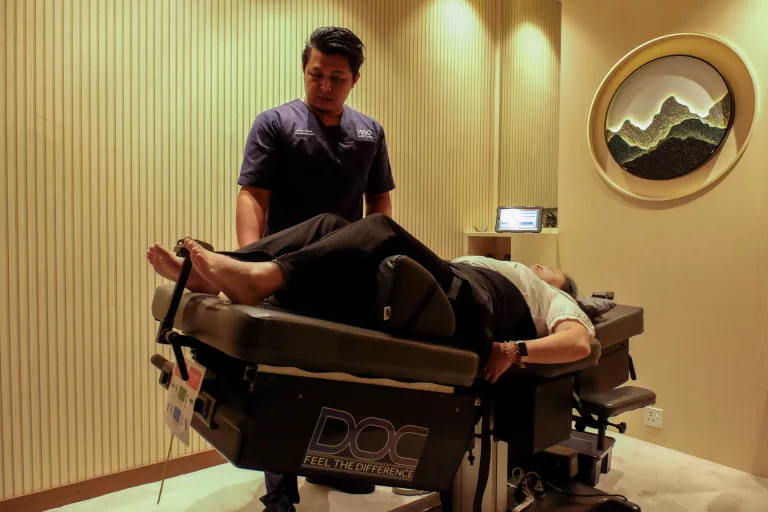Decompression Therapy for Spinal Stenosis: Can It Relieve Pressure and Pain?
Spinal stenosis is the type of pain that steals your comfort, your movement, and your day. A simple walk around the block? Suddenly exhausting. Standing in line? Numbness or sharp jolts shoot down your legs. You’ve done the stretching, maybe even looked into injections. And yet, the discomfort lingers.
But there’s one more option: spinal decompression therapy. This treatment offers a non-invasive way to relieve pressure and give your spine some breathing room. Here’s what it can do for you.
What Is Spinal Stenosis?
Spinal stenosis happens when the space within your spine narrows, squeezing the nerves inside. It often shows up with age, especially if you’ve had wear and tear in the bones or discs of your spine. Most people notice it in the lower back (lumbar spine) or neck (cervical spine). Common signs include:
- Back or neck pain
- Numbness or tingling in your arms or legs
- Weakness when walking
- Pain that eases when you sit or lean forward
Stenosis can get worse over time, especially if left untreated. That’s where decompression therapy comes in.
What Is Spinal Decompression Therapy?
Spinal decompression therapy is a non-surgical treatment designed to stretch your spine in a controlled, gentle way. The goal? To relieve pressure on the spinal discs and nerves.
By gently stretching the spine and creating more space between the vertebrae, decompression therapy helps reduce this pressure, improving nerve function and reducing symptoms like numbness, tingling, or radiating pain in the arms or legs. For many patients with stenosis, this non-invasive approach offers a safer alternative to surgery, especially when combined with a personalized treatment plan.
Some people feel immediate relief, while others see gradual improvement over several sessions.
What Happens During a Spinal Decompression Therapy Session?

You’ll lie on a motorized table, usually face up, and are securely strapped in. The device gently stretches your spine in controlled cycles, each lasting a few seconds to a few minutes. You won’t feel pain, but you might notice a pulling sensation or light pressure.
A typical session lasts around 15–20 minutes. Most treatment plans include 10 to 20 sessions over several weeks, depending on your condition.
How Effective Is Spinal Decompression Therapy for Different Types of Spinal Stenosis?
Spinal decompression therapy isn’t one-size-fits-all but it does show promise across several regions of the spine. The results depend on where your stenosis is located, how severe it is, and how your body responds to treatment.
Lumbar Spinal Stenosis (Lower Back)
This is the most common type of spinal stenosis, and it responds best to decompression therapy. People with lumbar stenosis often experience leg pain, cramping, or numbness while walking — a condition known as neurogenic claudication.
Spinal decompression therapy can ease pressure on the lumbar nerve roots, helping to improve mobility and reduce pain that radiates down the legs. Many patients notice that they can walk longer or stand more comfortably after a few sessions. When combined with spinal adjustment, results tend to last longer.
Cervical Spinal Stenosis (Neck)
Decompression therapy can also help those with cervical stenosis, especially when symptoms involve radiating arm pain, tingling, or numbness. The goal here is to gently stretch the neck to reduce pressure on the spinal cord or nerve roots.
Cervical traction, a form of decompression applied to the neck, can be particularly effective for improving neck mobility, reducing stiffness, and relieving pressure-related symptoms.
If you’re unsure which area is affected, our chiropractors can confirm the location of your stenosis with x-ray imaging and help you determine if decompression therapy makes sense for your situation, or if another treatment would be more suitable.
Is It Effective?
Many patients report significant improvements in pain and mobility after completing a full course of therapy. It’s especially helpful for those with mild to moderate stenosis or disc problems.
The benefits may include:
- Less nerve compression
- Better spinal alignment
- Improved circulation and disc hydration
- Relief from chronic back or neck pain
- More ease with walking and standing
Let Us Help You Recover Your Spine as Your Age at Osso Bone Care
Decompression therapy offers a gentle, non-invasive way to manage spinal stenosis and other disc-related conditions. If you’re looking for pain relief, better mobility, and a lower-risk alternative to surgery, it’s worth exploring.
Talk to one of our expert chiropractors at Osso Bone Care to see if decompression could be part of your care plan and take that first step toward moving more freely again.
